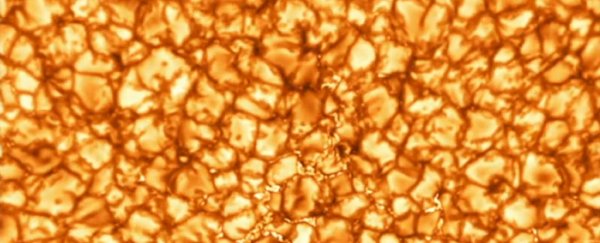You can't tell from Earth, but the Sun's outer atmosphere is hundreds of times hotter than its surface – it's a long-standing mystery that astrophysicists have been working on for years, and now we might just have an answer.
Scientists have previously suggested that solar plasma jets called spicules shooting up from the interior were responsible for the heating effect, and for the first time this latest research has directly observed this process.
The new observations show that as magnetic fields on the surface of the Sun reverse and realign, spicules are formed.
The magnetic field energy is converted into kinetic and thermal energy, which is then transferred to the spicules pushing up through the chromosphere to the outermost layer of the Sun's atmosphere, the corona.
 A multi-layered view of solar spicules. (NJIT)
A multi-layered view of solar spicules. (NJIT)
The idea of the Sun's magnetic tension triggering spicules has been floated before, through the use of detailed computer simulations. Now, using high-resolution imagery from the telescopes at the Big Bear Solar Observatory (BBSO), astronomers have actually seen it happening.
"Unprecedented high-resolution observations from BBSO's Goode Solar Telescope clearly show that when magnetic fields with opposite polarities reconnect in the Sun's lower atmosphere these jets of plasma are powerfully ejected," says solar physicist Wenda Cao, from the New Jersey Institute of Technology.
And these jets are quite something, around 200-500 kilometres (124-311 miles) wide, and reaching heights of thousands of kilometres before collapsing. They move fast too – around 100 kilometres (62 miles) per second.
The researchers also used images captured by the NASA Solar Dynamics Observatory spacecraft in the extreme ultraviolet (EUV) spectrum to measure how energy was being transferred in the upper layers of the Sun's atmosphere.
Those images confirmed that spicules could reach temperatures of around 1 million degrees Celsius (1.8 million degrees Fahrenheit). That burst of high energy might well be enough to heat the corona to the high temperatures scientists have recorded.
Key to all this crucial data gathering is the high resolution pictures possible with the BBSO, offering up levels of detail that just haven't been possible before. As our space-observing tech improves, more discoveries should follow.
"This is the first time we've seen direct evidence of how spicules are generated," says Cao.
"We have tracked these dynamic features in the H-alpha spectral line down to their foot points, measured the magnetic fields at their foot point, captured the migration of the emerging magnetic elements and verified their interaction with existing magnetic fields of the opposite polarity."
We've still got plenty to learn about the swirling, volatile ball of magnetism and plasma that is our Sun, but scientists are steadily peeling back the layers of mystery – even if they have to recreate the Sun on a much smaller scale here on Earth.
And while the new study isn't enough to comprehensively prove that spicules are heating up the corona – more research and observations will be needed for that – we now understand spicules and their cycles much better than before.
"Our observations of the formation of spicules, the subsequent heating, and the return flows reveal a complete mass cycling process between the chromosphere and corona," write the researchers in their published paper.
The research has been published in Science.
